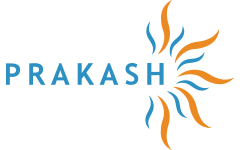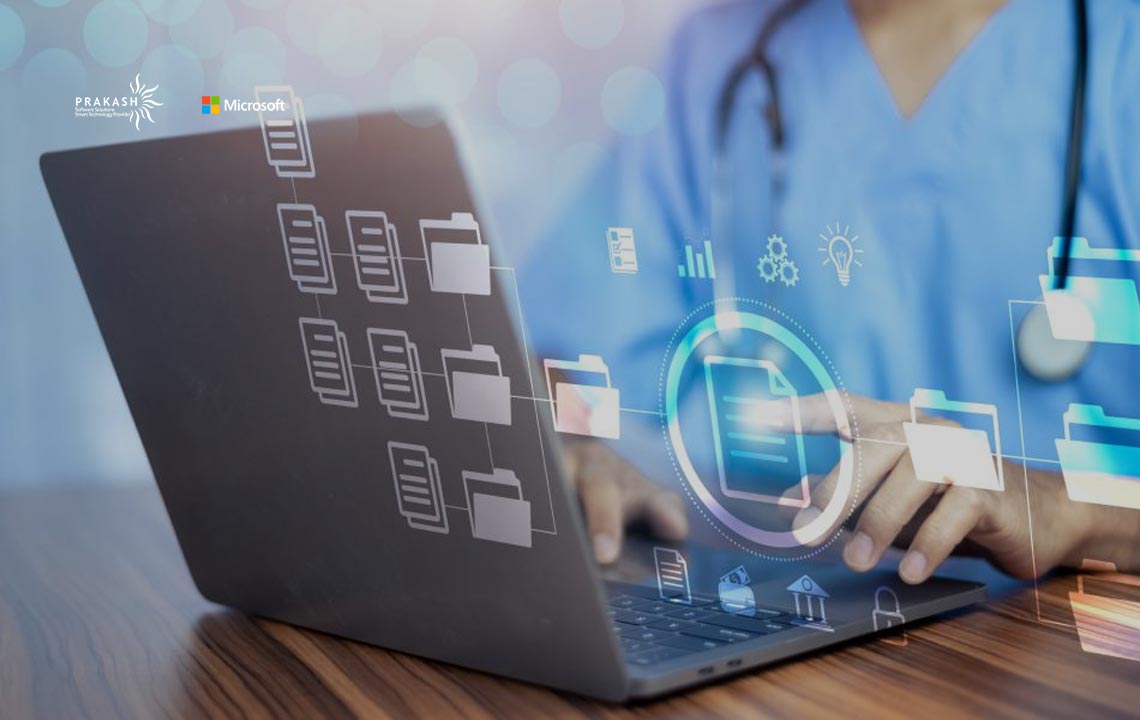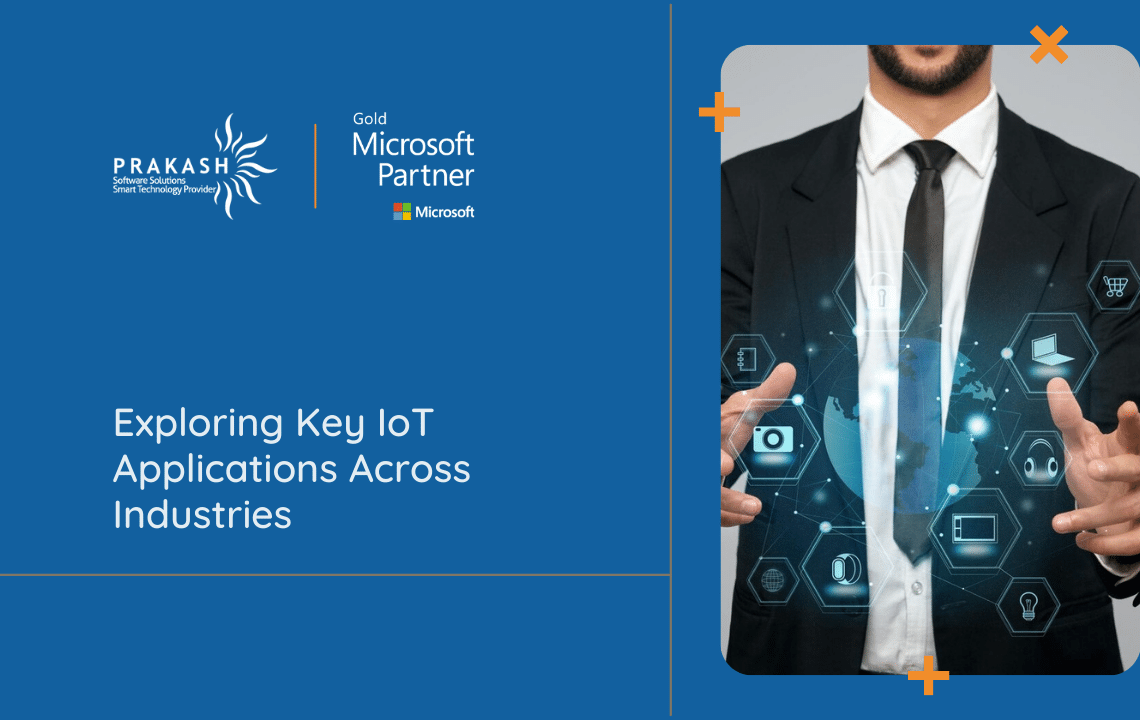
Exploring Key IoT Applications Across Industries
IoT transformed technology from buzzword to practical solution, reshaping our perspective.
Are you eager to use this breakthrough in your upcoming projects? Discover diverse IoT applications in sectors like finance and banking with our comprehensive guide.
What’s Driving the Popularity of IoT?
Many industries have been impacted by the Internet of Things, primarily due to urbanization and population increase. Its uses, however, go well beyond smart cities. The industries where IoT is expected to have the biggest influence are manufacturing and healthcare. These together account for the majority of the worldwide IoT market share.
IoT market set to surpass $662B in 2023, projected to hit $3.4T by 2030, marking exponential growth. Over 15 billion IoT devices bridge physical and digital realms, showcasing staggering connectivity. By 2030, this number should have almost doubled to 30 billion, according to Statista. IoT’s vast connectivity and transformative potential make it a pervasive phenomenon across industries, rapidly gaining momentum.
Check out our IoT development services, which are tailored to IoT finance and banking. We would also get along with insights into IoT in the industrial industry. Let’s get started with different use cases across different industries.

IoT in Banking and Finance
The future of the banking industry is poised to deliver unparalleled convenience to users, with IoT emerging as the cornerstone technology fueling this transformative journey in banking and finance, bolstering the fintech paradigm. Centered on elevating digital customer experiences through fortified security, streamlined processes, streamlined paperwork, and data-centric analytics, IoT presents a myriad of advantages across various facets of banking and finance.
Let’s delve into some pivotal Internet of Things use cases reshaping the landscape of the banking and finance sector:
Robust Cybersecurity & Fraud Prevention: Fortifying security and combating cyber threats entail strategic IoT deployments, such as the integration of surveillance cameras for on-premises monitoring and IoT sensors to vigilantly monitor networks for any suspicious activities. Motion sensors, access control systems, and other IoT applications play a pivotal role in bolstering fraud prevention measures.
Enhanced Digital Banking Channels: The focal point of digital banking is to elevate customer experiences. IoT Banking and Finance offers contactless payments, biometric security, location-based services, and more for enhanced customer convenience.
IoT-Enabled ATMs: The banking industry’s operations are made more efficient by the IoT ecosystem that is integrated into ATMs. The Internet of Things enables ATMs to perform intelligently by utilizing connected devices and sensors, guaranteeing improved security protocols. It also helps in smooth operation, and customized consumer experiences. Smart ATMs autonomously monitor downtime, trigger notifications, and provide tailored customer experiences.
Smart Branch Ecosystems: Among banks and other financial service providers, the introduction of IoT-driven smart branches is a highly desired use case. Smart branches, outfitted with IoT technologies, provide individualized customer service, streamline operations by tracking queue lengths to reduce wait times. It also improves security measures, and provide a variety of operational efficiencies.
IoT in Manufacturing Industry
In the manufacturing industry, IoT emerges as a transformative force, offering multifaceted enhancements across operational workflows. From refining processes to monitoring equipment and streamlining maintenance endeavors, IoT integration within manufacturing operations primarily targets amplifying operational efficiency. Leveraging the capabilities of IIoT (Industrial Internet of Things), manufacturers harness smart sensors and actuators to elevate industrial and manufacturing processes.
Let’s explore the pivotal IoT use cases within the manufacturing sector:
Inventory Management: IoT’s transformative impact on inventory management yields significant cost savings of approximately 15% while boosting turnover by 10%. It enables robust management of goods flow, facilitates optimal inventory levels, and ensures timely fulfillment of customer orders through real-time visibility of stock.
Asset Tracking: Within manufacturing operations, assets such as machinery, equipment, and tooling serve as pivotal components. IoT-powered asset tracking applications empower manufacturers to receive real-time updates on asset performance and health, enabling close monitoring to mitigate downtime. With enhanced asset safety assurances, IoT facilitates seamless execution of modern supply chains, optimizing end-to-end logistics cycles, and effectively managing inventory levels.
Workforce Safety & Security: Through wearable IoT devices, manufacturing environments witness significant advancements in ensuring workplace safety. Real-time environmental monitoring capabilities enable prompt alerts and notifications in abnormal scenarios, facilitating the tracking of field workers’ locations, and expediting rescue processes with data-driven insights.
Fleet Management: IoT-driven fleet management solutions leverage real-time data collection via embedded sensors. This helps to monitor various variables including vehicle location, fuel consumption, engine health, and acceleration. This data empowers efficient fleet operations management, facilitating optimized route planning, and enhancing vehicle performance and utilization.
IoT in Retail Industry
Retail stands as one of the vanguards in embracing IoT devices and applications. Let’s delve into the pivotal capabilities of IoT within the retail industry through the following use cases:
Supply Chain & Logistics Optimization: IoT-driven ecosystems amplify the overall efficiency of retail operations. Seamlessly integrated IoT devices provide comprehensive visibility into product shelves, transit routes, and warehouse functionalities. Through IoT cloud integration, sensors gather vital data concerning shipment location, travel distance, estimated time of arrival (ETA), humidity levels, and other critical parameters, thereby ensuring enhanced management and continuity of business operations.
Facility Management: Integration of IoT-based sensors and devices within retail facilities empowers owners to uphold hygiene standards by analyzing foot traffic patterns garnered from entry gates. This data facilitates astute product management and placement strategies, while also bolstering the physical safety and security of retail premises.
Automated Checkouts: The quest of unmatched consumer experiences is at the core of the retail sector. Retail establishments can automate the checkout process entirely by implementing IoT-powered self-checkout systems. Enhances shopping with shorter queues and tailored experiences, meeting modern consumer expectations seamlessly.
IoT in Healthcare
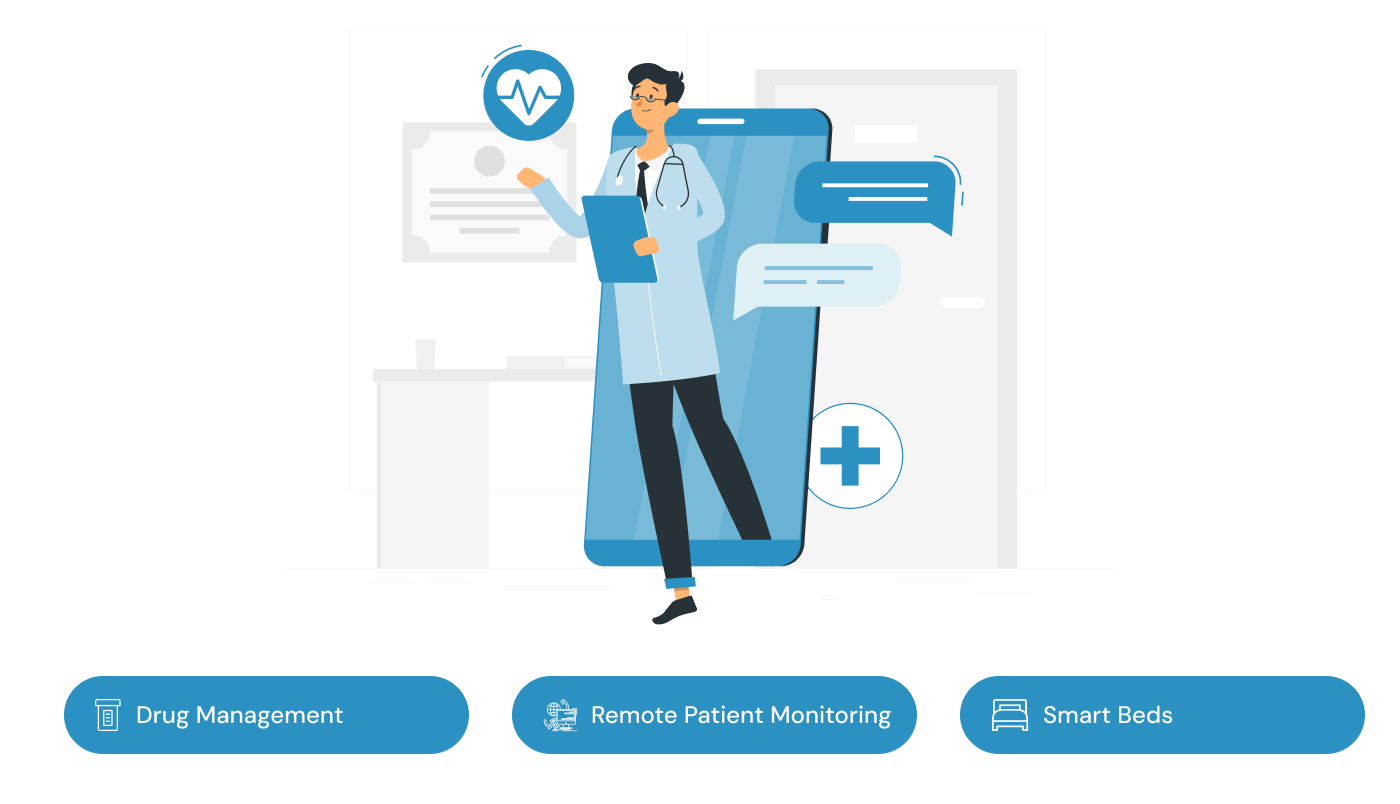
IoT revolutionizes healthcare delivery, driving significant advancements in recent years. Optimizing IoT applications in healthcare is crucial to maximize their effectiveness across diverse use cases. Let’s delve into a paramount use case of IoT within the healthcare sector:
Drug Management: The healthcare sector can improve drug tracking and management procedures by implementing Internet of Things (IoT) remote refrigerator monitoring systems. By using data analytics to reduce the risks of understocking and overstocking, these systems enable automated drug inventory management. This optimizes medicine utilization based on reports on consumption and demand.
Remote Patient Monitoring: Smartwatches, wearables with IoT capabilities, and sensors built into medical equipment are all essential instruments for this kind of monitoring. These smart devices allow for real-time monitoring and prompt intervention when needed by transmitting crucial health data, such blood pressure and heart rate, to medical professionals and interested parties.
Smart Beds: The use of smart bed technology is highly prioritized by hospitals, clinics, and healthcare service providers to ensure the best possible patient care, whether at home or in medical facilities. With the sensors and networking features that smart beds offer, doctors can monitor patients from a distance, take vital signs, and respond promptly when needed. This makes it possible to give more customized and adaptable care.
IoT in Real Estate
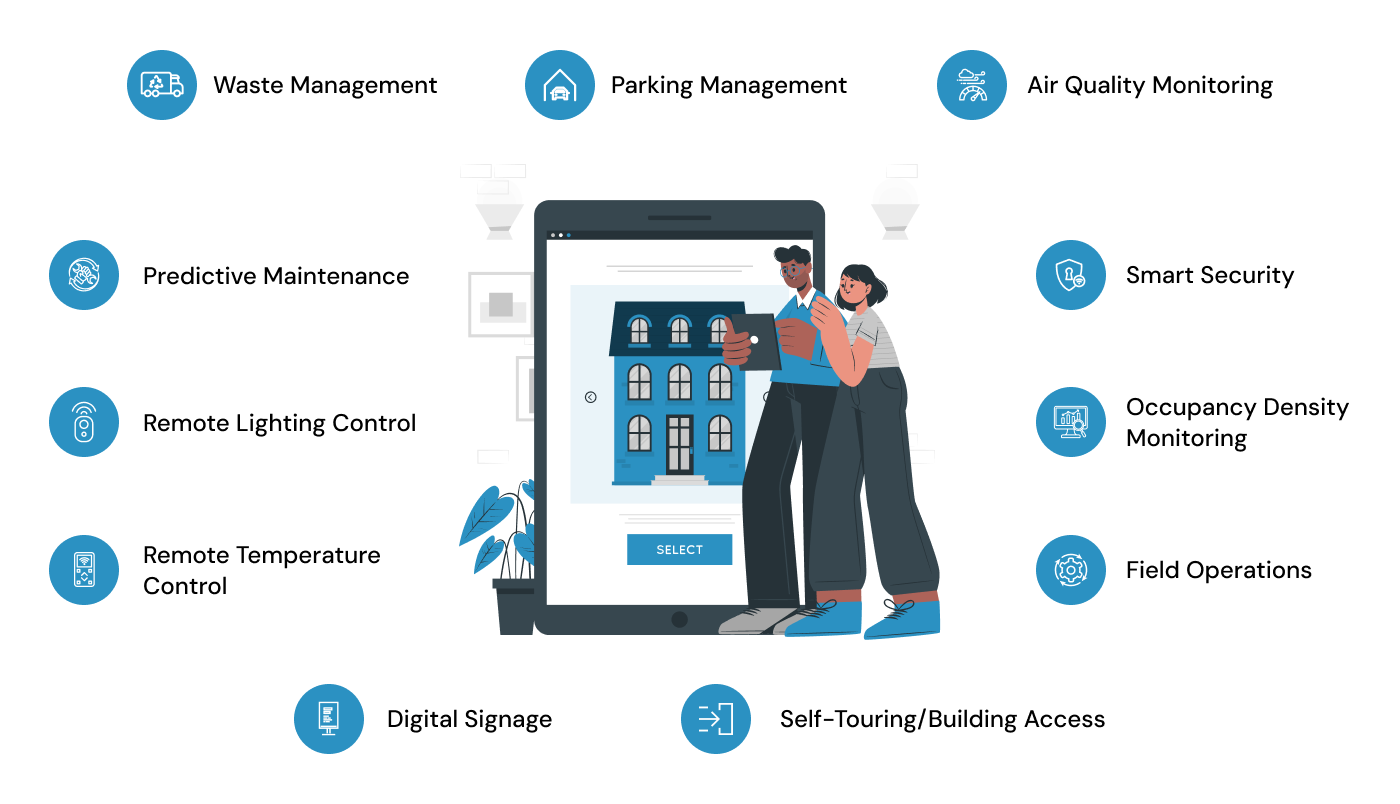
Waste Management: Elevate operational efficiency and tenant satisfaction through continuous waste area monitoring.
Parking Management: Maximize operational efficiency and improve tenant satisfaction by monitoring parking availability.
Air Quality Monitoring: Ensure tenant safety and comfort by continuously monitoring room air quality.
Predictive Maintenance: Proactively anticipate building asset maintenance needs to reduce costs.
Remote Lighting Control: Improve energy efficiency and operational performance with remote lighting management.
Remote Temperature Control: Ensure energy efficiency and tenant comfort by remotely managing HVAC systems.
Smart Security: Lower risk with connected locks and video surveillance for critical areas.
Occupancy Density Monitoring: Optimize workspace usage for increased productivity and cost savings.
Field Operations: Equip facility managers with connected devices for enhanced efficiency.
Digital Signage: Enhance communication and safety with digital displays for visitors and tenants.
Self-Touring/Building Access: Simplify property tours and access for renters to improve their experience.
Smart Home: Integrate home devices for enhanced lifestyle, security, and energy conservation.
IoT in Government/Public Sector (Smart Cities)
Public Space Surveillance: Strengthen public safety via connected security cameras and AI analysis.
Road & Traffic Management: Enhance traffic flow with data-driven control measures.
Disaster Prevention: Monitor environmental factors to avert disasters and ensure citizen safety.
Waste Management: Improve efficiency and citizen satisfaction by monitoring waste disposal areas.
Infrastructure Monitoring & Control: Manage infrastructure components for reduced maintenance costs and enhanced citizen experience.
Parking Management: Optimize parking usage with personalized guidance and reservation systems.
Digital Signage: Elevate communication efficiency and decrease wait times to enhance citizen engagement and safety.
Public Transportation: Enhance operational efficiency and passenger satisfaction with real-time monitoring and automated ticketing systems.
IoT in Education
Discover the potential of IoT in education with these envisioned use cases:
- Smart classrooms featuring interactive displays and connected devices.
- Adaptive learning platforms tailored to individual student needs.
- Virtual classrooms and online collaboration tools for remote learning.
- Smart infrastructure with IoT-managed HVAC, water, and lighting systems.
Wrapping Up
At PSSPL, we specialize in providing IoT development services tailored to various industries, including banking and finance and manufacturing. Our services span IoT project lifecycle: requirements, architecture, development, testing, and continuous support, ensuring comprehensive assistance.
Our expertise extends to partnering with organizations of all sizes, from startups to large corporations, to deliver custom IoT solutions. As a leading IoT consulting company, we excel in offering comprehensive IoT consultation, solution deployment, and maintenance services.
This helps in fostering connected environments across industries. With our proficiency in technology domains, we empower various sectors with enhanced visibility, agility, and future sustainability through IoT innovation.
Happy Reading!
